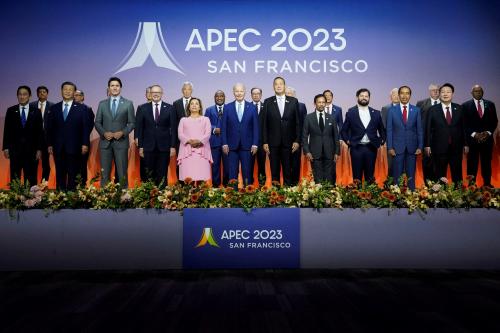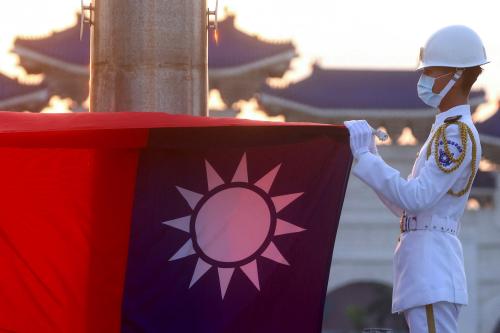Relations between Japan and China, the two great powers of Northeast Asia, in recent months have sunk to their worst levels at least since Tiananmen Square in 1989. The last two weekends’ anti-Japanese riots in China were unprecedented in recent times but were only the latest in a series of highly unfortunate events.
The new Sino-Japanese tension is probably welcomed in some parts of the Pentagon. It draws Japan closer to the United States militarily—on issues like possible conflict against China in the Taiwan Strait—when most of the rest of Asia is successfully wooed by China as it softens its image and increases its economic power. But left unchecked, worsening tensions between Asia’s greatest high-tech power and its fastest-growing economy could make for a strategic rivalry reminiscent of early 20th century Europe. That cannot be good for anyone’s interests.
Tension in the China-Japan relationship has powerful historical roots. Chinese citizens have never forgiven Japan for the aggression and atrocities of the 1930s and 1940s, such as the Nanjing massacre, which together killed at least hundreds of thousands of Chinese. Ironically, during the Cold War, China did not have the luxury of nurturing such grudges—and Japan was sufficiently penitent, or at least muzzled enough by postwar guilt, not to stoke the embers of painful memories. But now a strong and increasingly nationalistic China can dream of a future, stronger global role—and also remember the past. Among other things, it spreads a very critical message about Japan in textbooks its schoolchildren still read.
For its part, Japan is finally emerging from the shackles of World War II, partly due to prodding from the United States, which now wants a stronger global partner. This is mostly to the good. Japanese democracy has become strong, and its soft power—as well as its military, in modest doses at least—can contribute to international stability.
But Japanese politicians have begun to tire of apologizing for predecessors’ crimes and sometimes let pride and their own strengthening nationalism cloud their better judgment. That in turn stokes the worst fears and anti-Japanese sentiments of Chinese, Koreans and others in the region.
For example, unlike his predecessors, Japanese Prime Minister Junichiro Koizumi has made a habit of visiting the Yasukuni shrine in Tokyo, where many war dead but also 14 “Class A” war criminals are enshrined. In the last couple of years, China and Japan rekindled old disputes over contested islands, mostly small and unpopulated. Last fall, a Chinese submarine was caught snooping in Japanese territorial waters. This winter, Tokyo agreed with Washington to consider possible conflicts over Taiwan within the explicit purview of the U.S.-Japan alliance. China has also been searching for energy resources in a seabed zone both countries claim.
Then earlier this month, Chinese newspaper headlines heralded that Japan’s government had approved a new school textbook omitting much crucial information about the massacres in Nanjing and other atrocities of the 1930s and 1940s. That less than 1 percent of Japanese schools are likely to use the book and that Japanese textbooks today are far better than during the 1982 Sino-Japanese textbook controversy is little-known among Chinese citizens.
What to do about these dangerous trends? Each of the three main countries must take prompt steps to prevent the problem from worsening.
Japan: Approval of the right-wing textbooks is in fact not as bad a problem as it sounds. It is the nearly inevitable result of policy changes in the 1980s designed to improve textbooks, making them more reflective of real history and Japan’s aggressiveness in the 1930s and 1940s, in part by providing textbook authors greater latitude. But Japan needs to find a way to do even better. Perhaps a Japan-China joint textbook committee, patterned after the post-World War II Germany-Poland model (or the current Japan-Korea joint history research committee), could help.
China: While it has every right to harbor deep anger about the past and even some fear about the present and future Japanese character, China also needs to recognize how much Japan has changed. And China’s leaders must be responsible for informing their citizens about Japan’s numerous apologies and commitment to a peaceful foreign policy. Almost all Japanese are well aware of the country’s historical transgressions, and most textbooks refer clearly to the great suffering Japan inflicted on its neighbors in the past. Few Japanese vote for ultranationalist politicians (it must be acknowledged that the governor of Tokyo is an exception—but his is a domestic, not an international, post).
And perhaps most difficult of all, China should not be surprised that Japan is gradually outgrowing the guilt and the timidity that resulted from World War II. Furthermore, any nationalistic tendencies in its politics are strongly countered by its postwar pacifism. Both Japan and China should work toward a mutually acceptable plan for joint development of any energy sources discovered in the seabed near the disputed islets.
The United States: In addition to prodding Beijing and Tokyo to do the above, Washington needs to declare it favors a stable and cooperative Japan-China relationship and emphasize to China it does not see the U.S.-Japan alliance as fundamentally directed against the Chinese. To be sure, the alliance is a hedge against Chinese aggression. But it is also a way to deal in the near term with acute traditional threats like North Korea, and over a longer time a potential way to undergird stronger regional security structures that should include China to conduct peace operations, counterpiracy missions and, of course, counterterrorism. The recently announced U.S.-China strategic dialogue is a good place for Washington to voice such reassurances. And the United States should support a comparable Japan-China strategic dialogue.
The above is only a partial list dealing with some of the acute problems between East Asia’s two most important countries. But by focusing on such steps promptly and seriously, Tokyo, Beijing and Washington can return their relationships to the positive trajectory generally followed in recent years—and on which future regional peace and stability so heavily depends.



Commentary
Op-edCalming the Japan-China Rift
April 21, 2005